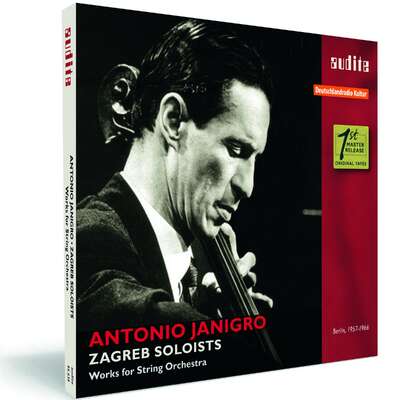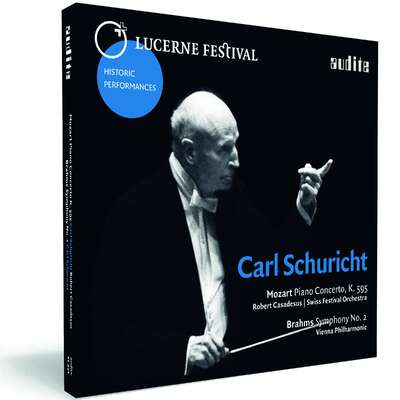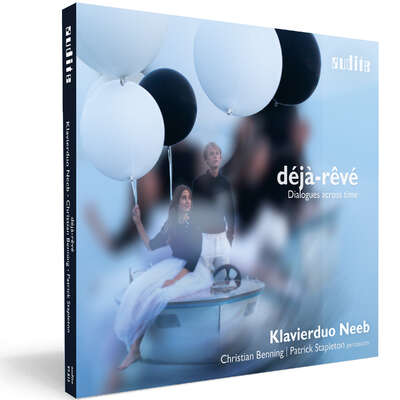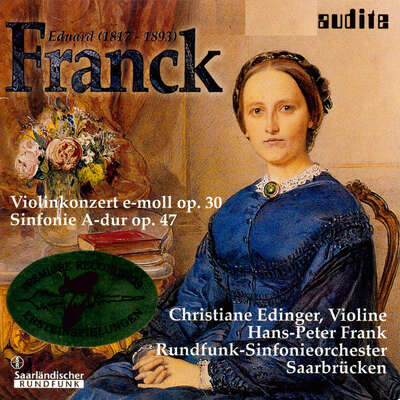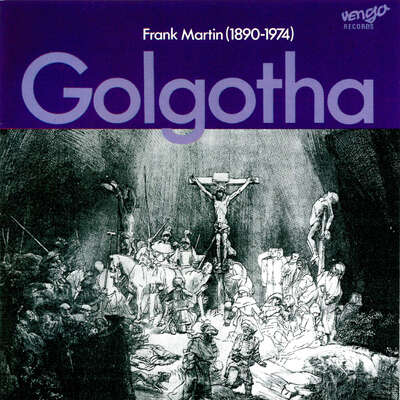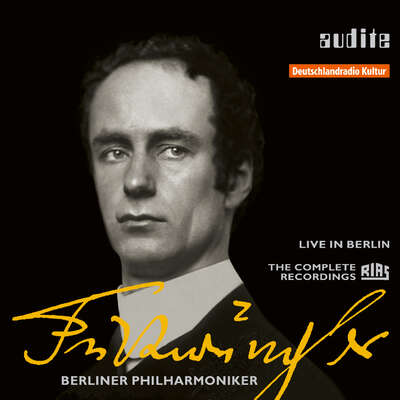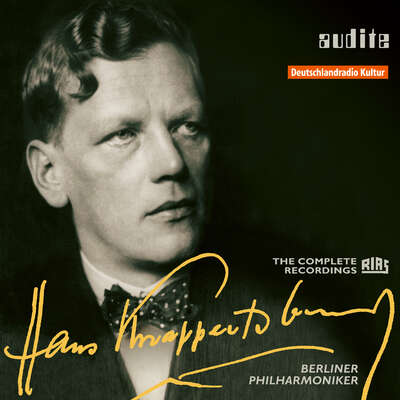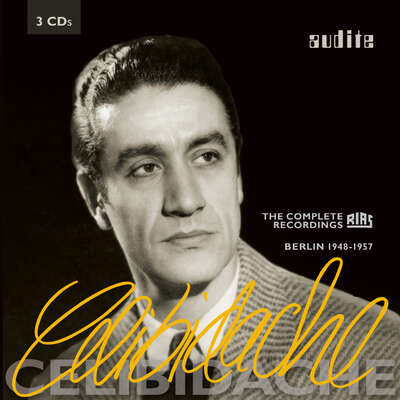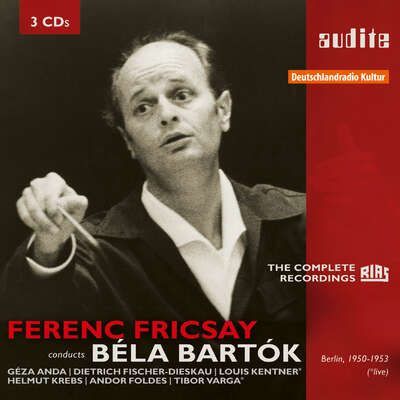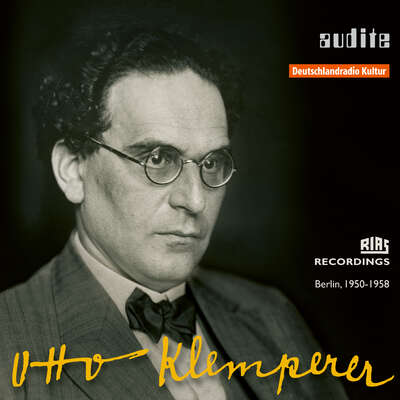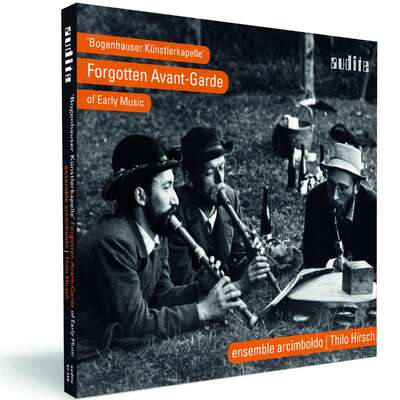
Ferenc Fricsay was seen as an exponent of modern, detailed and precise music-making , and as a leading Mozart conductor alongside Bruno Walter and Karl Böhm. Two live recordings and one studio production from the early Fifties document the collaboration between Fricsay and “his” RIAS...more
"Auch die Aufnahmen von Mozarts Symphonien Nr. 29, 39 und 40 sind historische Perlen. Fricsay stellte bereits Anfang der Fünfzigerjahre die Weichen für ein neues Mozart-Verständnis, das sich durch extreme Klarheit, einen dramatischen Ablauf und einen konsequenten Ablauf definiert. Kein Gefühl von Lieblichkeit mag da aufkommen, er strafft die Musik, verzichtet auf Nettigkeit und zeigt Mozart unverblümt und ehrlich als einen modernen, ernsthaften und kritischen Komponisten." (Pizzicato)
Details
| Edition Ferenc Fricsay (VII) – W.A. Mozart: Symphony No. 29, No. 39 & No. 40 | |
| article number: | 95.596 |
|---|---|
| EAN barcode: | 4022143955968 |
| price group: | BCB |
| release date: | 29. October 2008 |
| total time: | 79 min. |
Bonus Material
Informationen
Ferenc Fricsay was seen as an exponent of modern, detailed and precise music-making, and as a leading Mozart conductor alongside Bruno Walter and Karl Böhm. Two live recordings and one studio production from the early Fifties document the collaboration between Fricsay and “his” RIAS Symphony Orchestra which, after becoming its chief conductor in 1948, he had made into an elite ensemble. These recordings also document his esteem for Mozart’s music which was characterised by a deep seriousness. Fricsay’s devotion to sculpting the melodic line finds a precise and supple medium in the meticulous and stylish RIAS Symphony Orchestra who display an astonishing quality, particularly in the live recordings.
There is a “Producer’s Comment” from producer Ludger Böckenhoff about this production available.
The production is part of our series „Legendary Recordings“ and bears the quality feature „1st Master Release“. This term stands for the excellent quality of archival productions at audite. For all historical publications at audite are based, without exception, on the original tapes from broadcasting archives. In general these are the original analogue tapes, which attain an astonishingly high quality, even measured by today‘s standards, with their tape speed of up to 76 cm/sec. The remastering – professionally competent and sensitively applied – also uncovers previously hidden details of the interpretations. Thus, a sound of superior quality results. CD publications based on private recordings from broadcasts cannot be compared with these.
Reviews
ensuite Kulturmagazin | Mai 2016 | Francois Lilienfeld | May 1, 2016 Aufnahmen mit Ferenc Fricsay (2.Teil)
[…] Neben der Deutschen Grammophon gebührt auch der Firma audite ein großes Lob für ihre Bemühungen, Fricsay-Aufnahmen einem breiten Publikum zuMehr lesen
Audite 95.498 enthält zwei Konzertmitschnitte. Mit dem inzwischen in «Radio-Symphonie-Orchester Berlin» umbenannten RIAS-Orchester interpretiert Ferenc Fricsay Tschaikowskys Fünfte. Der Vergleich mit der DGG-Aufnahme von 1949 ist interessant: In beiden Aufführungen versteht es der Dirigent, die oft recht scharfen Kontraste zwischen Wildheit und lyrischen Stellen überzeugend darzubringen – und die Streicher des RIAS stehen den Berliner Philharmonikern in nichts nach: Beide Klangkörper sind grossartig. Die audite-Version ist jedoch besser durchdacht, konsequenter aufgebaut, insbesondere in den Mittelsätzen. Dies mag auch am Anlass liegen: Das Konzert vom 24. Januar 1957 fand zum zehnjährigen Jubiläum des Orchesters statt – ein besonders inspirierender Moment. Es ist schön, dass die CD auch die kurze Ansprache des Dirigenten enthält.
Mit dem anderen Dokument auf dieser Platte hat es eine besondere Bewandtnis: Es handelt sich um das Schumann-Klavierkonzert mit Alfred Cortot, 1951 mitgeschnitten. Eine brisante Geschichte, hatte doch Cortot während der deutschen Besatzung Frankreichs intensiv mit den Nazis und dem Vichy-Regime kollaboriert. Er nahm leitende Stellungen an und ignorierte zahlreiche Hilferufe bedrängter Künstler. Dies führte unter Anderem zum Bruch mit seinen früheren Trio-Kollegen und Freunden Jacques Thibaud und PabIo Casals. Doch etwas muss man ihm zugute halten (Das Folgende weiss ich dank den Memoiren von Casals): Im Gegensatz zu zahlreichen Kollegen, die sich mit Lügen und Rechtfertigungen durchschlängelten, oft sogar im Innersten Anhänger der Nazi-Ideologie blieben, zeigte Cortot Reue. Im Sommer 1945 besuchte er unangemeldet den großen Cellisten in Prades. «Es ist wahr, Pablo,» sagte er, «ich habe mit den Nazis gearbeitet, ich schäme mich, ich schäme mich furchtbar. Ich bin gekommen, um dich um Vergebung zu bitten.» So kann man denn die Tatsache, dass Cortot im Mai 1951 in Berlin spielte, auch als Geste der Versöhnung betrachten.
Soweit die zeitgeschichtlichen Hintergründe. Doch wie steht es mit der musikalischen Qualität? Da muss ich leider sagen, dass man diesen Mitschnitt besser hätte im Archiv schlummern lassen sollen. Auch ich bin kein Anhänger der Null-Fehler-Ästhetik (ein Ausdruck von Habakuk Traber im ausgezeichneten Beiheft). Zwei meiner Lieblingspianisten – Arthur Schnabel und Rudolf Serkin – passierten auch gelegentliche Schnitzer, aber eben: Sie geschahen gelegentlich und vermochten nicht, den gestalterischen Gestus zu stören. Bei Cortot jedoch hören wir regelmässig brutale Fehler, man hat dazu das Gefühl, dass Schumanns Partitur ihm gar nicht am Herzen liegt, so viele Willkürlichkeiten und Grobheiten erlaubt er sich.
Doch lassen sie sich nicht abhalten: Der Kauf der CD ist wegen der Tschaikowsky-Symphonie unbedingt empfehlenswert!
Auch in der audite-Serie finden wir Haydn- und Mozart-Symphonien. Leider sind es die gleichen, die schon bei DGG erschienen sind. Dies hängt wohl damit zusammen, dass Schallplattenaufnahmen oft im Anschluss an Radio-Produktionen stattfanden – und vergessen wir nicht, dass die Radio-Aufnahmen meist nicht zur Veröffentlichung bestimmt waren. Natürlich sind die Vergleiche interessant: Aber was gäben wir nicht dafür, statt zweimal KV 201 und KV 543 die «Linzer» und die «Prager» zu haben!
Bei den Haydn-Symphonien 44 und 98 spielt auf der audite Produktion zumindest ein anderes Orchester, nämlich das Kölner Rundfunk-Symphonie-Orchester. (audite 95.584)
Bei Mozart fällt die Unkonsequenz bei den Wiederholungen auf, die wohl oft mit der Sendezeit oder der Beschränkung einer Schallplattenseite zusammenhängt, wenn die Firma unbedingt eine ganze Symphonie auf eine Seite drängen wollte. In der A-dur-Symphonie KV 201 wiederholt Fricsay die Exposition des 1. Satzes bei DG, aber nicht bei audite. In der Es-dur-Symphonie KV 543 hält er es umgekehrt… Bei diesem Werk ist im Übrigen der Vergleich der beiden Fassungen des Trios im 3. Satz reizvoll: Hier die RIAS-Klarinetten mit ihrem samtweichen Ton, bei DG die Bläser der Wiener Symphoniker, die dem Wienerisch-Folkloristischen im Klang näher sind und etwas herber klingen. Die Qualität ist in beiden Fällen fabelhaft.
Die sehr kurze Exposition im g-moll-Werk wird immer wiederholt. (Symphonien Nrn 29, 39, 40: audite 95.596)
Eine absolute Sternstunde bietet audite mit der Einspielung von Donizettis «Lucia di Lammermoor» (audite 23.412). Diese Radio-Produktion von Januar 1954 wurde in deutscher Sprache aufgenommen, was damals eher der Normalfall war. Auch die vorgenommenen Kürzungen – 105 Minuten Spielzeit anstelle von gut anderthalb Stunden – entsprechen der Gewohnheit der Zeit; man musste noch lange auf komplette Aufführungen und Einspielungen warten. Dramaturgisch schwerwiegend ist vor allem das Fehlen der Begegnung zwischen Enrico und Edgardo am Anfang des dritten Aktes, wo sich die Gegenspieler zum Duell verabreden. Dadurch wirkt die letzte Szene – der Monolog Edgardos – nicht ganz folgerichtig. Dazu kommt das Problem, dass zwei gleich aufgebaute Szenen unmittelbar aufeinander folgen: erst Jubel, dann Umschwung ins Dramatisch-Tragische.
Auch die kurze Szene nach der Wahnsinnsarie, in der Enrico Reue zeigt, wäre für den dramatischen Ablauf wichtig: Ohne sie verschwindet diese Figur plötzlich im Nichts... Interessante Bemerkungen zu diesem Thema sind im Übrigen im ausgezeichneten Beiheft-Text von Habakuk Traber nachzulesen.
Doch, seien wir zufrieden mit dem, was wir haben: Denn die Aufführung ist schlicht und einfach überwältigend! Fricsay erweist sich einmal mehr als hochbegabter Dramatiker, RIAS-Orchester und -Chor (Einstudierung: Herbert Froitzheim) sind in Hochform. Zum Ereignis wird die Aufnahme jedoch durch Maria Staders Interpretation der Lucia. Gesangstechnisch und stimmlich kenne ich keine ebenbürtige Interpretin dieser Rolle, ausser Dame Joan Sutherland – und das ist aus meiner Feder ein Riesenkompliment! Maria Staders Porträt ist im Ansatz allerdings verschieden: Sie ist eine leidende Figur, eine Tragödin der leisen Töne. Den Wahnsinn stellt sie zurückhaltend, als Phantasma dar, nicht als dramatischen Gestus. Dass sie sich dabei genau an Donizetttis Notentext hält, ist ein weiterer Pluspunkt. Und der/die ungenannte Flötist(in) ergänzt den Gesang auf perfekte Weise. Ihr Partner, Ernst Haefliger, bewältigt die für ihn im Prinzip zu gewichtige Partie durch Intelligenz und perfektes technisches Können (ähnlich wie den Florestan im vor einem Monat besprochenen Fidelio). Wenn die beiden Künstler sich im Duett vereinigen, entsteht ein selten erreichter Wohlklang, ein perfektes Zusammengehen zweier zauberhaft schöner Stimmen; wahrlich, wir sind in der Welt des Belcanto!
Dietrich Fischer-Dieskaus Wutausbruch in der ersten Szene geschieht manchmal auf Kosten der Gesangslinie. Doch, ab dem Duett mit Lucia ist seine Interpretation des Enrico ein Modell an Gesang und Differenzierung. Auch die kürzeren Rollen sind sehr gut besetzt. Ein schottisches Sujet, von einem Italiener komponiert, auf deutsch aufgeführt: Wenn die Qualität stimmt, geht auch das!
Erwähnt sei noch, dass audite auf einer Doppel-CD die in der letzten Ensuite-Nummer hochgepriesene Aufnahme der «Fledermaus» als Einzelausgabe veröffentlicht hat (audite 23 411), mit einer hochinteressanten Dokumentation von Habakuk Traber im Beiheft.
Die Tonkunst | Juli 2013 | Tobias Pfleger | July 1, 2013 Edition Ferenc Fricsay – Werke von Haydn, Mozart, Beethoven, Rossini, Bizet, Brahms, Strauß, Verdi, Bartók u. a.
Ferenc Fricsay gehörte zu den bedeutenden Dirigenten des mittleren 20.Mehr lesen
Classic Collection | THURSDAY, DECEMBER 30, 2010 | Mortimer H. Frank | December 30, 2010
Many musicians, whether conductors, soloists, or chamber groups, often feelMehr lesen
Diapason | N° 580 S Mai 2010 | Rémy Louis | May 1, 2010 Un Hongrois à Vienne
La discographie officielle de Ferenc Fricsay pour Deutsche Grammophon est vaste et bien connue. Et pourtant, Audite nous comble en révélant cesMehr lesen
Si l'édition de concerts miroirs de gravures officielles ne s'impose pas toujours (ce que l'on vérifiait tout récemment avec la Messe en ut de Mozart publiée par Tahra, cf. n° 578), l'exploration des archives radio peut ressusciter des merveilles. L'anthologie Strauss est de celles-là. Ferenc Fricsay a certes laissé des gravures pour DG (en mono et/ ou en stéréo, avec Berlin ou le RIAS/ RSO) de plusieurs de ces œuvres, mais ces onze inédits au son glorieux sont musicalement irrésistibles.
Comme Reiner ou Szell, Fricsay est hongrois (né en 1914 !) pas viennois. Enregistrant ces valses et polkas aux fins de diffusion radio, il vise moins le romanesque aristocratique d'un Clemens Krauss, moins encore les langueurs (parfois) monotones de tant de ses successeurs, qu'une présentation limpide, quasi analytique. Admirable en soi, elle se double d'une sensibilité poétique si vibrante, d'un instinct si pur du style, d'une verve rythmique si efficace que ce Johann Strauss très ciselé évoque le naturel d'un Pierre Monteux dirigeant Delibes ou Tchaïkovski. De leur côté, les timbres de l'orchestre du RIAS n'offrent pas le raffinement charmeur de ceux du Philharmonique de Vienne, mais ils ont du caractère.
Exquisément nuancés, rythme et mélodie s'accordent idéalement. Les enchaînements sont au cordeau, et la fraîcheur aérée du ton, contagieuse. Mais que survienne une modulation, un passage plus pensif, et une merveilleuse mélancolie affleure. Ecoutez seulement l'introduction de Das Spitzentuch der Königin ou de Künstler-Leben: des ritenutos et une longueur d'archet subtilement variés achèvent de donner à ce bouquet une saveur entêtante.
Un mozartien de tout premier ordre
Les mêmes qualités foncières illuminent des Mozart tout aussi inédits et bien enregistrés. Fricsay est un mozartien de tout premier ordre, partout célébré pour sa gravure de La Flûte enchantée (DG). Pourtant, deux éléments enrichissent ici l'image que l'on avait de cette partie de son répertoire: d'une part, le choix de tempos partout assez retenus (proches d'un Böhm dans la 29e, au contraire donc de l'absurde précipitation d'un Cantelli dans ces mêmes années); d'autre part, la conscience très claire qu'un dramatisme d'essence proprement symphonique n'est en rien le décalque mal taillé de la théâtralité plus extérieure propre à la fosse.
Ce chef jeune – en 1950, année d'enregistrement de la 39e, il a trente-quatre ans – laisse sourdre une mélancolie, presque une noirceur, qu'on lui connaîtra plutôt après sa maladie, au tournant des années 1960, avant la rechute qui devait l'emporter. Les gravures DG officielles avec les Wiener Symphoniker, parues en 1960-1961, ne l'expriment pas exactement de la même manière, peut-être parce que, outre le son lui-même, le grain et les timbres (les bois en particulier) en sont très différents.
Ces captations possèdent un rayonnement, une hauteur de vue, une grandeur – l'introduction Adagio de la 39 e! – , très supérieurs à ce que proposent la quasi-totalité des mozartiens pressés actuels. Aussi parce que la subtilité du détail, la cohérence et la maîtrise de l'architecture obéissent à une autre exigence, et sont le fait d'un très grand chef! Notons que, moins limité par le médium radiophonique, Fricsay observe ici les reprises de la 39e, absentes chez DG.
Apostille: réclamons à nouveau l'édition de la Symphonie n° 1 de Dutilleux donnée le 28 mai 1953 à Cologne (et conservée par la WDR) dans un programme moderne qui comportait également des compositions de Werner Haentjes et Constantin Régamey.
American Record Guide | July/August 2009 | July 1, 2009 Mozart: Symphonies 29, 39, 40
This Hungarian conductor died young, in 1963 at less than 50. He had studied with Bartok and Kodaly but was also known as a Mozart specialist andMehr lesen
Fanfare | Issue 32:6 (July/Aug 2009) | Mortimer H. Frank | July 1, 2009
Many musicians, whether conductors, soloists, or chamber groups, often feel more comfortable—and do their best work—in front of an audience ratherMehr lesen
But in No. 39, the one work here recorded in the studio (in 1950), Fricsay gave a performance as fine as any I know, one in which the music’s contrasts of lyric gentleness and affirmative thrust are conveyed superbly. And the instrumental balance is first-rate, winds cutting through the texture to clarify significant detail often lost in recordings of the period. According to the insert notes, it was made for Deutsche Grammophon. Oddly, however, I could find no reference to it either in old Schwann catalogs or in WERM, which suggests that it may never have been released in English-speaking countries. It is certainly the kind of Mozart one would expect from Fricsay, who left justly admired recordings of the composer’s C-Minor Mass and Abduction from the Seraglio.
In all three recordings here, the sound is slightly metallic in string tone, but otherwise fine for its time. In No. 29, Fricsay observes exposition repeats in outer movements; in Nos. 39 and 40, only in the first movement. Whatever its shortcomings, for those interested in the conductor or in a splendid No. 39, this release is worth having.
Gramophone | June 2009 | Lindsay Kemp | June 1, 2009
Elegant Mozart combines fine interpretations with slick playing technical untidinesses liable to occur in any live situation, but more important thanMehr lesen
Scherzo | mayo 2009 | Enrique Pérez Adrián | May 1, 2009 Fricsay,Karajan
Sigue la extraordinaria Edición Frícsay en el sello alemán AuditeMehr lesen
Audiophile Audition | April 2009 | Gary Lemco | April 12, 2009
Live and studio recordings from the RIAS archives featuring Ferenc FricsayMehr lesen
www.classicstodayfrance.com | Janvier 2009 | Christophe Huss | January 10, 2009
L'interprétation mozartienne a évolué plus que d'autres, mais lesMehr lesen
Pizzicato | 1/2009 | Alain Steffen | January 1, 2009 Abenteuer Musik
Wenn es derzeit einen Preis für die interessantesten Booklets geben würde, so wäre meine Wahl schnell gefallen. Anstatt die immergleichenMehr lesen
Fricsays ‚Entführung’ von 1949 ist der fünf Jahre späteren DGG-Aufnahme in meinen Augen leicht überlegen. Sie ist in erster Linie lebendiger und spontaner, berührt und amüsiert weitaus mehr als die etwas steril und kontrolliert anmutende Produktion von 1954. Sari Barabas ist eine leichte und sehr lyrische Konstanze, Anton Dermota ein geschmeidiger und stilvollendeter Belmonte, Rita Streich gibt die wohl beste Blondchen der Schallplattengeschichte während Helmut Krebs als Pedrillo keine Wünsche offen lässt. Josef Greindl ist als Osmin einfach köstlich, allein seine stimmgewandte Interpretation ist die Anschaffung dieser Doppel-CD wert.
Fricsays Fledermaus stand immer etwas im Schatten von den beiden Wiener Produktionen unter Clemens Krauss und Herbert von Karajan. Eigentlich zu unrecht, wie man leicht feststellen kann. Die Dialogregie von Heinz Tietjen, der sich ebenfalls für die Dialoge bei der Entführung verantwortlich zeigte, ist vorzüglich, der Gesang besitzt allerhöchstes Niveau, wenn auch der Einstein von Peter Anders (wie auch der von Patzack unter Krauss) Geschmackssache bleibt. Fricsay distanziert sich in seinem virtuosen Dirigat von der typisch wienerischen Operette und zeigt, dass man mit straffen Tempi und markanten Akzenten diese Oper erst gar nicht in die Nähe des Kitsches bringen muss.
Auch die Aufnahmen von Mozarts Symphonien Nr. 29, 39 und 40 sind historische Perlen. Fricsay stellte bereits Anfang der Fünfzigerjahre die Weichen für ein neues Mozart-Verständnis, das sich durch extreme Klarheit, einen dramatischen Ablauf und einen konsequenten Ablauf definiert. Kein Gefühl von Lieblichkeit mag da aufkommen, er strafft die Musik, verzichtet auf Nettigkeit und zeigt Mozart unverblümt und ehrlich als einen modernen, ernsthaften und kritischen Komponisten. Ein Mozart-Bild, das sicherlich nicht von seinen Kollegen Furtwängler, Walter und Karajan geteilt wurde. Nur Otto Klemperer hatte vor Harnoncourt und Co. den gleichen Mut, Mozart von dieser Schiene der Gefälligkeit abzubringen.
Demnach sind alle drei Produktionen wichtige musikhistorische Dokumente, die wir heute als richtungsweisend erkennen und aus denen wir auch jetzt noch lernen können. Die drei Mozart-Symphonien und die Entführung besitzen darüber hinaus einen wirklichen Referenzcharakter. Und dank eines an sich hervorragenden Klanges kann man sich diese Aufnahmen mit allergrößtem Vergnügen anhören. Eine Firma wie Audite kann man nur ermutigen, so weiter zu machen und dem Musikliebhaber weitere Schätze zugänglich zu machen.
Saarländischer Rundfunk | SR 2 KulturRadio, CD-Neuheiten - 13.12.2008, 16:00 | Friedrich Spangemacher | December 13, 2008
Unsere erste Station führt uns ca. 50 Jahre zurück, zu Ferenc FricsaysMehr lesen
Journal de la Confédération musicale de France | Décembre 2008 | December 1, 2008
Les symphonies de Mozart par Fricsay sont de la même classe, un peu sagesMehr lesen




















